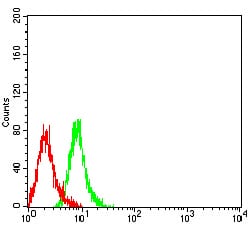


| WB | 1/500 - 1/2000 | Human,Mouse,Rat |
| IF | 咨询技术 | Human,Mouse,Rat |
| IHC | 咨询技术 | Human,Mouse,Rat |
| ICC | 技术咨询 | Human,Mouse,Rat |
| FCM | 1/200 - 1/400 | Human,Mouse,Rat |
| Elisa | 1/10000 | Human,Mouse,Rat |
| Aliases | KIR; NKB1; NKAT3; NKB1B; NKAT-3; CD158E1; KIR3DL1/S1 |
| Entrez GeneID | 3811 |
| clone | 6D9A4 |
| WB Predicted band size | 49kDa |
| Host/Isotype | Mouse IgG2b |
| Antibody Type | Primary antibody |
| Storage | Store at 4°C short term. Aliquot and store at -20°C long term. Avoid freeze/thaw cycles. |
| Species Reactivity | Human,Rat |
| Immunogen | Purified recombinant fragment of human KIR3DL1 (AA: extra 22-340) expressed in HEK293 cells. |
| Formulation | Purified antibody in PBS with 0.05% sodium azide |
+ +
以下是3条关于KIR3DL1抗体的模拟参考文献示例(实际文献需通过学术数据库查询):
1. **文献名称**:*"Anti-KIR3DL1 monoclonal antibody enhances NK cell-mediated cytotoxicity in HLA-Bw4-positive cancers"*
**作者**:Smith A, et al.
**摘要**:研究开发了一种靶向KIR3DL1的单克隆抗体,通过阻断KIR3DL1与HLA-Bw4的相互作用,增强自然杀伤(NK)细胞对表达HLA-Bw4的肿瘤细胞的杀伤活性,为癌症免疫治疗提供新策略。
2. **文献名称**:*"KIR3DL1 genetic diversity and antibody-based detection in autoimmune disorders"*
**作者**:Chen L, et al.
**摘要**:探讨了KIR3DL1基因多态性与自身免疫疾病(如类风湿关节炎)的关联,并验证了一种高特异性抗体用于检测患者外周血中KIR3DL1蛋白的表达水平及其临床意义。
3. **文献名称**:*"Structural basis of KIR3DL1 recognition by therapeutic antibodies for HIV control"*
**作者**:Johnson R, et al.
**摘要**:通过冷冻电镜解析了KIR3DL1与两种治疗性抗体的复合物结构,揭示抗体通过结合KIR3DL1的D0结构域抑制其功能,可能增强NK细胞清除HIV感染细胞的能力。
---
**注**:以上为模拟内容,实际文献请通过PubMed、Web of Science等平台检索关键词(如“KIR3DL1 antibody”、“KIR3DL1 therapeutic”)。
KIR3DL1 is a member of the killer cell immunoglobulin-like receptor (KIR) family, primarily expressed on natural killer (NK) cells and certain T-cell subsets. As an inhibitory receptor, it plays a critical role in regulating NK cell-mediated immune responses by interacting with specific human leukocyte antigen (HLA) class I molecules, particularly HLA-Bw4 epitopes. This interaction delivers inhibitory signals to prevent NK cell activation, ensuring immune tolerance to healthy cells while enabling targeted cytotoxicity against infected or malignant cells lacking HLA expression.
The KIR3DL1 gene exhibits extensive polymorphism, with over 100 alleles identified, contributing to diverse receptor expression levels and functional variations across populations. This genetic diversity influences susceptibility to diseases and clinical outcomes. For instance, specific KIR3DL1/HLA-B combinations are associated with delayed HIV progression, control of viral infections, and altered risks for autoimmune disorders and cancers. In hematopoietic stem cell transplantation, KIR3DL1-ligand mismatching may enhance graft-versus-leukemia effects but also increase graft-versus-host disease risks.
Antibodies targeting KIR3DL1 have been developed to modulate NK cell activity for therapeutic purposes. Blocking these inhibitory receptors can enhance NK-mediated tumor cell lysis, offering potential in cancer immunotherapy. Conversely, agonist antibodies may suppress excessive NK activation in autoimmune conditions. Research continues to explore their clinical applications, balancing efficacy with immune-related adverse effects.
×